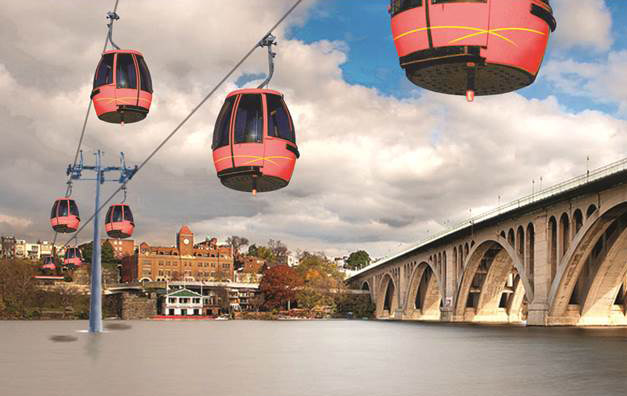WASHINGTON — Why build a new bridge over the Potomac River when a sky gondola would do the trick — at least, that’s what the Georgetown Business Improvement District says.
The organization proposed a gondola — think of it as an enclosed ski lift — to move pedestrians between Georgetown and the Rosslyn Metro Station across the river in its 2028 plan. Released two years ago, the plan re-imagines how tourists, students and city-dwellers connect with and use the Georgetown neighborhood.
But that pedestrian-ride-in-the-sky plan may be gaining some momentum.
The District’s 2016 transportation budget currently sets aside $35,000 to help pay for a feasibility study. The improvement district has raised another $130,000 to put toward the study, says Kelly Whittier, spokeswoman for D.C. Councilwoman Mary Cheh, who chairs the transportation committee.

Whittier says the funding is a tiny piece of a $13 billion citywide budget, but it’s in response to business owners who have been advocating for the gondolas as part of efforts to reinvigorate the Georgetown economy.
Arlington County is also interested in exploring the feasibility of the gondolas and officials are trying to figure out where its $35,000 contribution would come from, says county spokeswoman Mary Curtius.
The urban county supports the use of alternate modes of transportation and officials there want to know to what extent the aerial cable cars would contribute to the region’s transit mix, as well as tourism, Curtius says.
Rosslyn’s improvement district and Georgetown University have also pitched in to pay for the study, says Joe Sternlieb, CEO of the Georgetown Business Improvement District.
The 2028 plan also calls for a new Metro station, described as a top priority by the business group. But construction of a Metro stop is likely years or decades away, Sternlieb says.
“We’re looking for an interim solution to create the equivalent of a Metro stop in Georgetown by linking it to the Rosslyn Metro Station,” Sternlieb says.
Under the cable car system envisioned by the improvement district, cabs would arrive every 12 to 15 seconds, ready to whisk riders across the river in 3.5 minutes – virtually eliminating the waiting that typically accompanies public transit, he says.
And that wait can deter transit ridership. Today, Metro riders who want to go to Georgetown have to wait for a bus outside the Rosslyn Station and cross the Key Bridge. Some may choose to simply drive instead, he says.
Eliminating deterrents to public transportation, like the wait, would increase transit ridership and could ultimately reduce congestion and possibly pollution in the historic neighborhood, all of which the study would explore.
Construction of the cable car traverse could take 12 to 18 months, he says, but the study is the first step.
D.C. isn’t the only city considering sky gondolas as a public transit option. Buffalo, New York, is floating the option to connect its harbor and downtown. And the South American country of Bolivia has invested in a system of public transit cable cars to connect parts of its steep capital city, La Paz.
Local officials and business leaders first came across the sky cable cars during a trip to Portland, Oregon. They group, which included Sternlieb, took a trip on a gondola up a hill to a medical center overlooking a river. Someone suggested the lift would be a great way to link Georgetown with Virginia.
“We all laughed,” he says.
Several years later, the idea re-emerged and the business district decided to test how people would respond.
“Much to my surprise, the idea was extremely popular with citizens groups, the university, business people and some of the elected leaders.”







